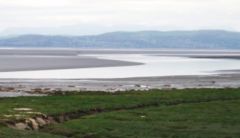Morecambe Bay
2007 Schools Wikipedia Selection. Related subjects: Geography of Great Britain
Morecambe Bay is a large bay in northwest England, nearly due east of the Isle of Man and just to the south of the Lake District National Park. It is the largest expanse of intertidal mudflats and sand in the United Kingdom, covering a total area of 310 km². Towns on the bay include Barrow-in-Furness, Ulverston, Grange-Over-Sands, Morecambe, Fleetwood and Heysham.
The rivers Leven, Kent, Keer, Lune and Wyre drain into the Bay, with their various estuaries creating a number of peninsulas within the bay, such as Humphry Head.
Much of the land around the bay is reclaimed, forming saltmarshes used in agriculture. Morecambe Bay is also an important wildlife site, with abundant bird life and varied marine habitats, and there is a bird observatory at Walney Island.
The bay is also notorious for its quicksand and fast moving tides (it is said that the tide can come in "as fast as a horse can run"). There have been royally appointed local guides (holding the post of Queen's Guide to the Sands) for crossing the bay for centuries. This difficulty of crossing the bay added to the isolation of the land to its north which, due to the presence of the mountains of the Lake District, could only be reached by crossing these sands or by ferry, until the Furness Railway was built in 1867. This skirts the edge of the bay, crossing the various estuaries. The West Coast Main Line also briefly runs alongside the bay - interestingly, the only place where the London-Glasgow railway actually runs alongside the coast.
Morecambe Bay was featured on the television programme Seven Natural Wonders as one of the wonders of the North.
Bridge Discussion
Discussions as to whether to build a road bridge over the bay have been ongoing for decades, particularly in the more isolated north of the bay. The most recent suggestion was of a "green bridge", flanked by wind turbines and using tidal power to mitigate the environmental damage of its construction . The bridge would be twelve miles long and stretch from Heysham to Barrow-in-Furness, at the bay's mouth. Feasibility studies are ongoing, though over two years since this version of the bridge was proposed, little progress has been made. In the 2005 UK General Election, Timothey Bell polled just 1.1% of the votes in the Barrow and Furness constituency for the Build Duddon and Morecambe Bay Bridges Party.
In 1974 gas was discovered offshore, and development of the Morecambe Bay gas field began several years later. A lease has been granted for the development of two wind turbine sites in the bay, one at Walney Island and the other at Cleveleys. Together these will have around 50 turbines.
2004 Morecambe Bay Cockling Disaster
The bay has rich cockle beds, which have been fished by locals for generations. On the night of 5 February 2004, at least 21 Chinese immigrant cockle pickers drowned after being cut off by the tides. This tragedy led some commentators to suggest that the cockle beds should be closed until improved safety measures could be introduced.
